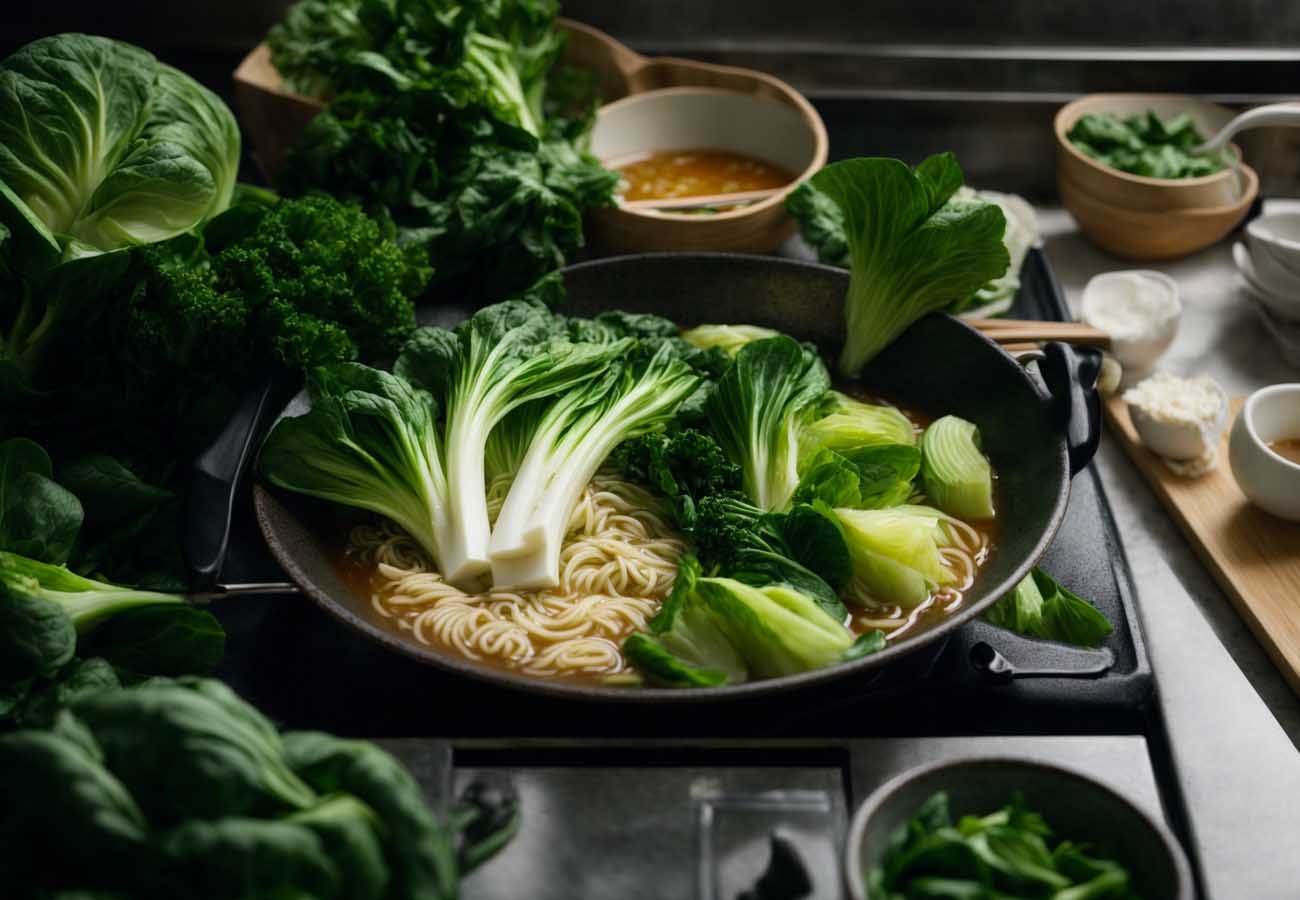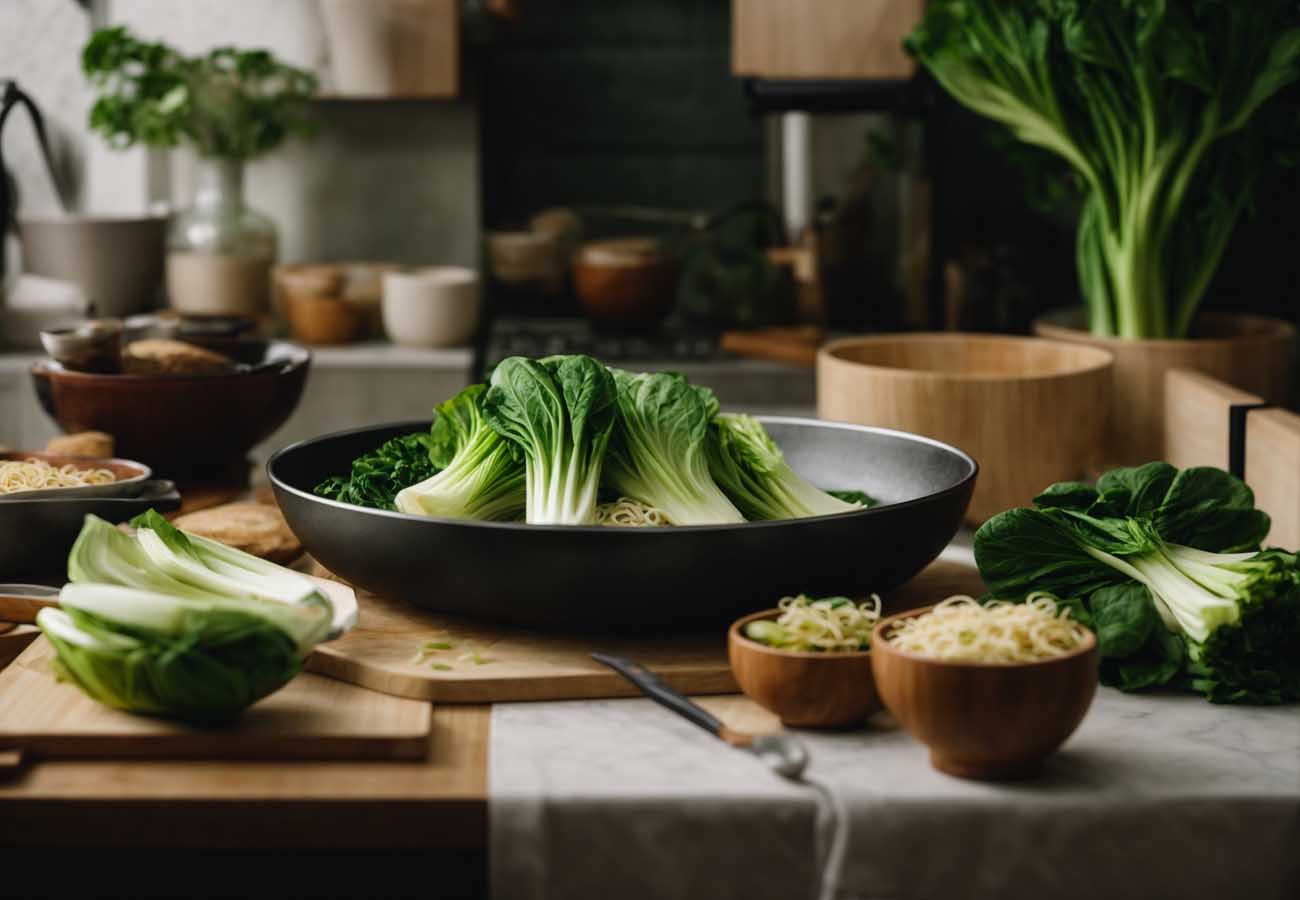Quickly blanch bok choy in boiling water for 1-2 minutes before adding it to your ramen. Ensure it retains its crisp texture and bright color before serving.
Preparing bok choy for ramen is a simple process that can significantly enhance your noodle experience. This leafy green integrates effortlessly with the umami flavors of ramen broth, introducing a welcome crunch and a boost of nutrients.
Renowned for its versatility and rapid cooking time, bok choy is an ideal addition to the comforting bowl of ramen, offering a balance of texture and freshness.
About Bok Choy in Ramen
Whether you’re a seasoned ramen enthusiast or a curious foodie looking to spice up your meal prep, understanding how to integrate bok choy into your ramen can transform your dining experience.
Let’s explore the wonders of bok choy in ramen and learn how this nutrient-packed vegetable can add both flavor and health benefits to your favorite bowl of noodles.
Understanding Bok Choy: A Versatile Asian Green
Bok choy, a type of Chinese cabbage, stands out in Asian cuisine for its versatility and delightful texture. With crisp stems and tender leaves, it can be sautéed, steamed, or even served raw. In ramen, bok choy offers a refreshing crunch and a mild, peppery flavor that complements the savory broth.
The Role of Bok Choy in Ramen Dishes
When it comes to ramen, bok choy acts as a flavor enhancer and texture provider. It’s typically added toward the end of the cooking process to maintain its crispness. The leaves soak up the broth’s essence while the stems provide a satisfying bite, ensuring that each spoonful is a harmonious blend of flavors and textures.
Nutritional Benefits of Incorporating Bok Choy Into Ramen
- Rich in Vitamins: Bok choy is an excellent source of vitamins A, C, and K.
- Mineral-Rich: It provides crucial minerals like calcium, magnesium, potassium, and iron.
- Low in Calories: Adding bok choy to your ramen is a great way to enhance the dish’s nutritional value without significant calorie intake.
- Dietary Fiber: Bok choy contributes to your daily fiber needs, promoting better digestion.
- Antioxidant Properties: It contains compounds that may have antioxidant benefits, contributing to overall health.
Selecting and Preparing Your Bok Choy
Bok choy, a crisp and nutritious leafy green, serves as the perfect crunchy companion to the rich, savory flavors of ramen. Master the art of selecting and preparing bok choy with these essential tips, ensuring a delightful burst of freshness in every spoonful of your ramen.
Choosing the Best Bok Choy for Ramen
To achieve that optimal texture and flavor in your ramen, selecting the right bok choy is vital. Aim for leaves that are vibrant green with firm stalks, indicating freshness and quality. Look for smaller varieties – baby bok choy is often more tender and milder in taste, making it an excellent choice for ramen dishes. Avoid leaves that appear wilted or have any signs of spotting or damage.

Cleaning and Cutting Techniques
Clean bok choy thoroughly as it often harbors dirt between the leaves. Start by chopping off the base, then separate the leaves and rinse under cold water. Shake off excess water or use a salad spinner to dry the leaves.
When cutting, consider the ramen’s presentation and texture:
- For a crisp texture, leave the stalks longer and the leaves larger.
- For a softer bite, slice the stalks thinly and chop the leaves coarsely.
To Blanch or Not to Blanch: Pre-cooking Bok Choy
While you can add bok choy directly to the ramen, blanching it beforehand can enhance its flavor and texture. Blanching also helps it retain a bright green color, making your ramen visually appealing. Follow these simple steps:
- Bring a pot of water to a boil.
- Add a pinch of salt to the boiling water.
- Submerge the bok choy for 30 seconds to one minute, depending on the size and thickness.
- Immediately transfer to an ice bath to stop the cooking process.
- Drain well before adding to your ramen.
Cooking Bok Choy for Ramen
The savory delight of ramen can be greatly enhanced by the addition of bok choy, a versatile and nutritious green. Not only does bok choy infuse the broth with a burst of color, but it also offers a tender crunch that complements the soft noodles and rich flavors.
Understanding how to cook bok choy for ramen is key to creating a balanced, hearty bowl. Let’s explore the best methods for preparing bok choy, ensuring every slurp is infused with its fresh, leafy goodness.
Sautéing Bok Choy for Enhanced Flavor
One popular method to elevate your ramen is by sautéing bok choy. This technique unlocks a depth of flavor that steaming simply can’t match. To begin:
- Rinse your bok choy thoroughly to remove any dirt that may be nestled in the leaves.
- Separate the leaves from the stems. The stems take longer to cook, so they’ll need a head start in the pan.
- Heat a drizzle of oil in a frying pan over medium heat. Sesame or vegetable oils are excellent choices for this purpose.
- Add the stems and cook for a few minutes until they start to soften.
- Toss in the leaves, stirring frequently, until they wilt and take on a vibrant green color, signaling they’re ready to grace your ramen.
This sautéing process enhances the bok choy with a lightly caramelized flavor that harmonizes exquisitely with the savory notes of ramen broth.
Steaming Bok Choy for a Healthier Option
For those looking for a lighter touch, steaming bok choy is an excellent method. This gentle cooking technique preserves the nutritional profile and provides a tender texture. The steps are straightforward:
- Prepare a pot with an inch of water and a steaming basket. Bring the water to a simmer.
- Cut the bok choy into preferred sizes and arrange them in the basket.
- Cover and let the bok choy steam for about 5 minutes, or until they reach your desired level of tenderness.
Once steamed to perfection, the bok choy can be added to your bowl just before pouring in the hot broth, retaining its crispness and bright color.
Timing: When to Add Bok Choy to Ramen
Proper timing is crucial for integrating bok choy into your ramen seamlessly. Add the bok choy during the last few minutes of the ramen cooking process to maintain its texture and color. If you’re sautéing, give the bok choy a quick pan toss before nestling it into the bowl.
Steamed bok choy should be placed atop the noodles just before pouring the broth ove. This ensures the leaves stay vibrant and stems tender, resulting in an optimally balanced dish.
Read more: How to Eat Bok Choy Raw
Incorporating Bok Choy into Various Ramen Styles
Bok Choy, a staple in Asian cuisine known for its crisp texture and mild flavor, is a fantastic addition to the comforting warmth of ramen. Whether it’s floating in a steamy bowl of Tonkotsu or nestled within a vibrant vegetable broth, this leafy green not only brings nutritional value but also enhances the ramen experience with its subtle crunch and aesthetic appeal.
Let’s explore exciting ways to infuse bok choy into different ramen styles, ensuring every slurp is both delicious and healthful.
Bok Choy in Traditional Tonkotsu Ramen
Traditional Tonkotsu Ramen, known for its rich and savory pork bone broth, pairs wonderfully with the fresh, leafy textures of bok choy. Here’s how to seamlessly merge the two:
- Blanch bok choy in boiling water for 30 seconds for a tender-crisp bite.
- Slice the blanched bok choy and lay it atop the noodles, allowing the heat to draw out its bright green hue.
- The bok choy’s mildness complements the creamy broth without overwhelming the other flavors.
Adapting Bok Choy for Vegetarian and Vegan Ramen
Bok choy is a star in vegetarian and vegan ramen bowls. Its versatility makes it an excellent component for those seeking plant-based options:
- Stir-fry bok choy with garlic and ginger to develop a fragrant accent before adding it to the broth.
- Use baby bok choy for a sweeter taste and an even more tender texture.
- Combine bok choy with other vegetables like mushrooms, carrots, and tofu for a nutrient-packed ramen.
Creative Twists: Pickling Bok Choy for a Zesty Addition
Take your ramen to new flavor heights by pickling bok choy. This zesty twist introduces a tangy profile that cuts through the richness of ramen broths:
- Chop bok choy and mix with a brine of vinegar, sugar, and spices, then refrigerate for at least an hour.
- Use the pickled bok choy as a garnish, providing a contrast in both texture and flavor.
- Enjoy the added kick it brings, especially to milder ramen variants.
Conclusion
Crafting bok choy for your ramen doesn’t have to be complex. With these easy steps, you’ll enhance your noodle bowl effortlessly. Embrace this leafy green’s versatility to elevate your ramen experience. Remember, the key is in the simplicity and freshness of your ingredients.
Explore the crisp allure of Bok Choy at Farm Pioneer – your invitation to elevate meals with nature’s best, straight from our bountiful fields. Happy slurping!
